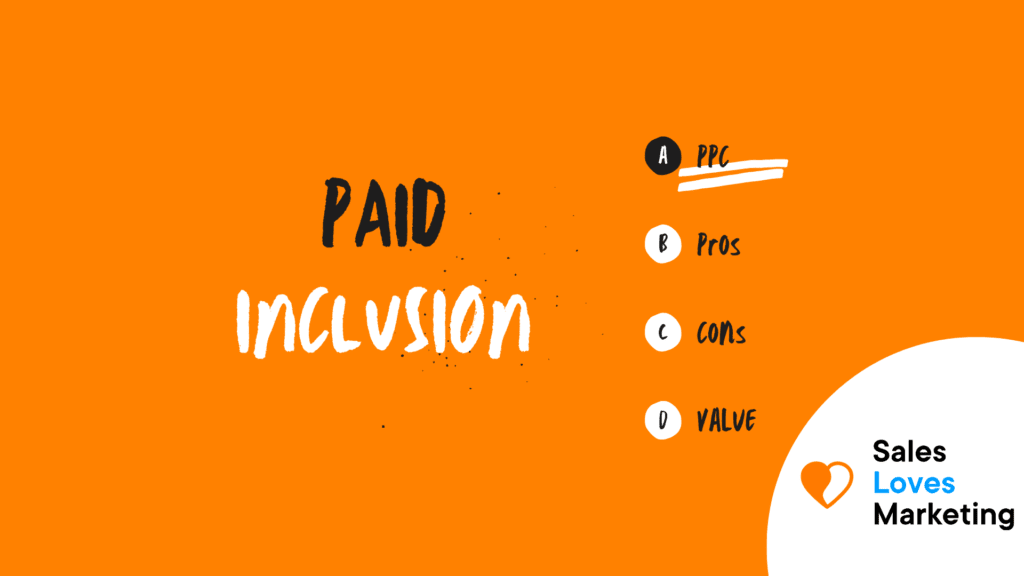What Is Paid Inclusion?
Paid inclusion is an SEO marketing model in which a website pays a fee to a search engine that guarantees that the site will be included and displayed in the search results returned for a given query. However, there are usually no guarantees.
How Does Paid Inclusion Work?
Paid inclusion is a type of search engine marketing in which search engines charge fees related to and linked to websites’ visibility and inclusion in their search index. Most of these search engine companies have paid inclusion products.
The way the pricing structure is constructed works simultaneously as a screen against minor exposures and as a revenue creator. Most of the time, the cost includes a subscription for a specified period of time for a website, which will be automatically and regularly cataloged. There are differences between each search engine. In some web pages, only paid inclusion is allowed, although there has been little success in these. Some search engines perform a combination of paid inclusion with normal crawling results from crawling robots. There are others that do not allow payments from website owners and webmasters to appear in search engine results.
The time it takes to get listed on Google is four to six weeks, and other search engines work like this. Some well-known search engines have a fairly inexpensive quick-include system. By registering under this modality, the website will begin to be displayed in approximately 48 hours. Inktomi, which gives results for MSN and other search services, has an inclusion program of $ 39 for the first URL sent, and the ones that follow cost $ 25. What is worth of Inktomi sending is that the URLs are visited every 48 hours, and when changes are made on the page, the results can be seen very quickly in the MSN listings. There are also payment inclusion methods for Alta Vista, Lycos, and Teoma
Want to get (quality) backlinks?; check out these services on Fiverr.
What Are The Differences Between Paid Inclusion And Pay Per Click?
Paid inclusion or sponsored listings: This SEO procedure is proposed by the major search engines, where websites and companies pay a price to be included and appear on the results pages. The client is given a cost structure that includes a subscription for a stipulated period of time so that the website or pages are included in the usual way. The cost sometimes includes a fee per click and per page, depending on the plans offered.
There are times when the difference between this particular form and pay per click is not well distinguished. It should be noted that you cannot control the list of content or rankings with paid inclusion. This means that pages that are frequently modified and created dynamically will attract crawlers’ attention and have a better chance of being indexed.
Pay Per Click (PPC): This procedure uses specific keywords or phrases that are displayed in the lists when users search for them. You decide and choose an amount to pay for each click that visitors make, which can vary from 10 cents to more than $ 50 for each click made. There is also a package that presents the listings on partner sites and various search engines. When a user enters a keyword or phrase, the link to paid advertisers is displayed in a specified area of the results page that lets advertisers manage the page lists and rankings.
What Are The Pros And Cons Of Paid Inclusion?
Pros
- Fast inclusion. Paid inclusion can make a website and all its associated pages indexed easily. There are no long waits for web pages to show up in search engine page results. As long as the web pages are linked to each other, they will all be indexed within a few days.
- Superiority when it comes to reindexing. Paid inclusion gets the search engine bots to re-crawl and index the website and pages for any changes made. Search engine bots are able to do this up to daily. What will bring as a result that the last update made in the web pages will be indexed in a simple way; and this, in turn, increases the ranking of the website, and the site traffic increases rapidly.
Cons
- Value or Cost. The inclusion of payment requires annual fees to the web pages that want to use it. Search engine fees can range from $ 170 to $ 600.
- Few options in terms of search engines. All search engines do not offer paid inclusions. The engine chosen may not have the paid inclusion option.
Get this all-in-SEO-tool and/or check out these SEO courses.
